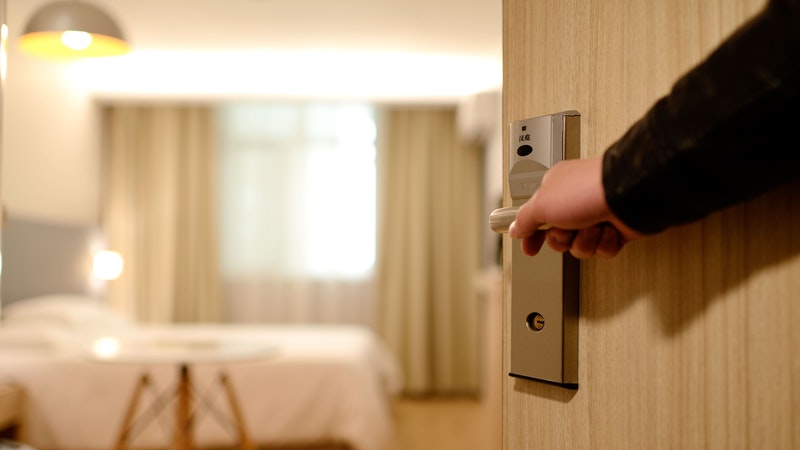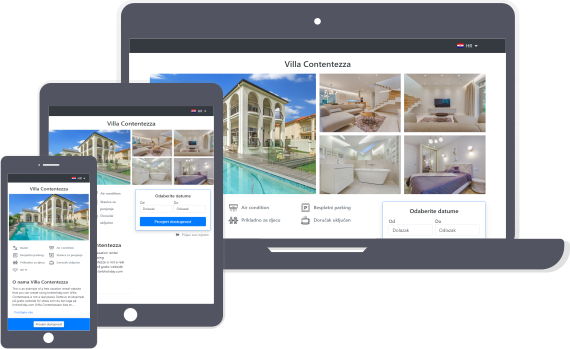Occupancy Percentage Calculator
Est. reading time: 7 min
Occupancy rate is the ratio of occupied rooms to the total number of available rooms at your property.
To find your occupancy rate during a certain period, enter the number of room nights sold, the total number of rooms available, and the length of the period, in days.
Table of Contents
- Definitions
- Why Calculate Occupancy?
- How to Interpret Occupancy Numbers
- How You Can Improve Occupancy
- Further Reading

Definitions
Occupancy
Occupancy (OCC) is the percentage of room nights sold on a given day or during a certain period.
You can calculate it as the ratio of room nights sold to room nights available.
Room Nights Sold
Room Nights Sold is the number of occupied and paid-for rooms at your property during a certain period.
Room Nights Available
Room Nights Available is the total number of room nights on offer during the period in question.
To calculate Room Nights Available, multiply the number of rooms at your property by the number of days in the period (given that all the rooms were available for sale all the time).
If some of the rooms at your property are unavailable for sale, for example, due to maintenance, you should exclude them from the calculation
Number of Rooms
The Number of Rooms is the number of rooms available for sale at your property.
Period
Period refers to the period for which you are calculating occupancy. Commonly used periods are a week, a month, 30 days, or a year.
Why Calculate Occupancy?
The occupancy rate shows how much of your availability is sold. This number is directly proportional to your revenue. The math is simple; the more room nights you sell, the more you earn. And the more you earn, the better, right? Keep in mind, however, that this is only true as long as you don’t sacrifice your average daily rate (ADR) in an attempt to boost occupancy. You should always balance the two to achieve the optimal revenue per available room (RevPAR).
Occupancy plays a very important part in your income generation. It is one of the Key Performance Indicators (KPIs) for accommodation providers. Together with the Average Daily Rate (ADR) and Revenue per Available Room (RevPAR), you can use it to determine how well your business is performing
Examples of Occupancy Percentage Calculation
To calculate the Occupancy Percentage, we can use the formula:
| Occupancy = | Room Nights Sold |
| Rooms Available · Days |
where Room Nights Sold is the total number of nights that were sold, Rooms Available is the number of rooms available for sale, and Days is the number of days in the period for which we are calculating Occupancy.
Using the formula above, we can perform some common occupancy percentage calculations:
Example 1: Occupancy Percentage for a 30 Day Period
If you have 25 room and have sold 526 room nights during the 30 day period, you can calculate your occupancy percentage to be:
| Occupancy = | 526 |
| 25 · 30 |
which is equal to 70.1%.

Create Your Own Vacation Rental Website
- Booking Calendar
- Multiple Languages
- Guest inquiries
- It's free to try!
Example 2: Occupancy Percentage for a Week
You have 10 rooms and have sold 57 room nights during the week. Your occupancy percentage is then given by:
| Occupancy = | 57 |
| 10 · 7 |
which is equal to 81.4%.
Example 3: Occupancy Percentage for a Single Day
If you have 5 rooms and 4 of them are occupied on a single day, then your occupancy percentage for that day is:
| Occupancy = | 4 |
| 5 · 1 |
which is equal to 80%.
How to Interpret Occupancy Numbers
High occupancy rates most often mean you have a healthy rental business. When more rooms are occupied, more income is generated. Be careful though: This is not true if your rates are too low or your expenses are too high.
Let’s illustrate this with an example:
You have 50 available rooms and all of them are occupied. In other words, you have a 100% occupancy. At a rate of $75 a night your income will be $3750.
If you instead start charging $100 a night, only 40 of your rooms get occupied and your occupancy drops to 80%. However, your income has increased, because you are now earning $4000, a whole $250 more than when you were fully booked.
If, in addition, if you need 4 cleaners to clean 40 rooms and 5 to clean 50 rooms, your cleaning expenses are reduced, and your net income is further increased.
In this case, it is much more profitable for you to operate with an 80% occupancy
Although high occupancy numbers are desirable because that means that space is used effectively, you must always remember that the number you are trying to maximize is net income, not occupancy.
If you consistently achieve close to 100% occupancy, the demand for your accommodation is high. In this case, you can probably earn more simply by raising your rates.
The correct way to interpret occupancy is to analyze it together with the average rate, average profit per available room, and costs. Only then can you determine if your numbers are good or bad.
How You Can Improve Occupancy
To improve occupancy you need to sell more room nights, and avoid empty rooms. There are several strategies accommodation providers use to achieve higher occupancy:
- Lower rates can attract more guests. This often happens at the expense of profitability, so be careful with this strategy. It can be difficult to recover your rates once the public has gotten used to the lower ones. Lowering the rates might also attract a different type of clientele than your preferred customer base.
- Promotions and Discounts can be a very effective strategy, especially when used to increase occupancy during slow periods. Such incentives are also effective when encouraging guests to promote your offer to their friends and family.
- Incentives for longer stays. Offer a discount to guests who book longer stays. If you have a lot of weekend stayovers, you can offer 30% off on the third night. This will encourage your guests to stay an extra day.
- Referrals. Encourage guests to write reviews and to invite their friends and family to book a stay with you.
- Marketing: social media, ads, etc. Marketing your business is often the main source of sales. Stay active on Facebook groups for vacation rental, Instagram, Twitter, etc. Large groups of people get inspiration for their next travel from these platforms.
- Online travel agencies (OTCs) are usually expensive but can be a good way to top off your occupancy. Especially if you have exhausted all other options.
- Selective audience. Targeting a niche audience can often create many referrals and reviews within that audience. It is much more probable for guests to talk about their experience with you if it’s special. This is especially true if the people they are talking to are in the same situation and looking for something similar. Catering to pets, families with kids, adults-only, outdoor experience, posh stays, etc. are examples of audiences you can target.
- Discourage cancellations by demanding a booking deposit and limiting or removing refunds, or offer special non-refundable rates.
-
Length of stay restrictions (LOS) are widely used by the hotel industry and offer an effective way to manage occupancy. They include minimum length of stay restrictions, maximum length of stay restrictions, days closed to arrival, or some combination of the above.
Minimum length of stay: By setting a minimum length of stay restriction during a period with high demand, you can increase occupancy during the slow period that follows. Some of the high-demand season spills over into the low-demand season. Tree days minimum or one week minimum are common restrictions.
Maximum length of stay restrictions: Do not accept long stays at a low nightly rate spilling into your high-demand periods from periods of low demand. The guests that extend their stay into high-demand periods should be charged full nightly rates according to demand.
Arrival day restrictions: Restricting the possible days of arrival (perhaps in combination with a minimum required length of stay), can have a positive effect on occupancy. By imposing such restrictions, you get more stayovers as opposed to new arrivals and can avoid single-day vacancies. An example of this strategy is only allowing guests to arrive on Saturdays and demanding they stay full weeks. This strategy works best during periods of very high demand.
Further Reading
Also, check out:
- Average Daily Rate (ADR) Calculator that calculates how much you charge per room, on average.
- Revenue per Available Room (RevPAR) Calculator that calculates how much you earn per room, on average.